Table of Contents
In today’s business world, workforce management is more important than ever. Organizations must have a solid plan to manage their employees to ensure they meet their goals and objectives.
This guide will teach you the basics of workforce management and help you to create a thriving workforce that contributes to your bottom line with the right tools and strategies.
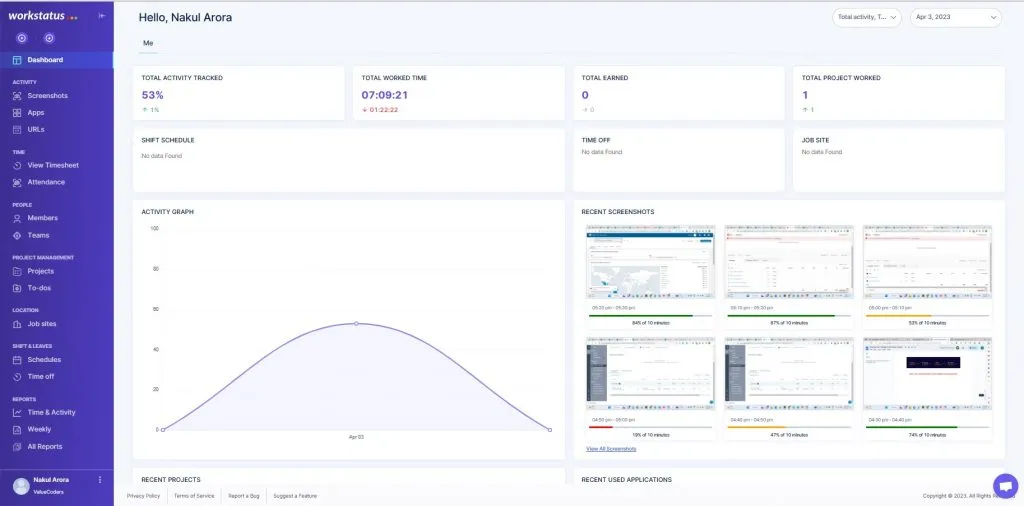
Read on to learn about everything from employee engagement to workforce planning and analytics.
What is Workforce Management?
Workforce management is organizing and managing your workforce to achieve optimal productivity. Successful workforce management requires understanding your employees’ roles, responsibilities, skill sets, and available resources to develop a strategy to meet organizational goals.
There are several approaches to workforce management, but all share the same goal, and that is to help you get the maximum return on investment from your employees.
However, the best method depends on various factors, like-
- The Nature Of The Work Being Performed,
- The Scope And Size Of Your Operation,
- The Availability Of Technology And Resources.
- Budget Constraints
- Organizational Culture
Regardless of your approach, workforce management is essential to running a successful business. You can improve productivity, morale, and bottom-line results by understanding your workforce and creating a work schedule that best meets the needs of your employees and organization.
Now let’s understand the
Top 5 Benefits of Workforce Management
1) Reduced Employment Costs
Workforce management can help organizations achieve significant cost savings by reducing the amount of time and money spent on manual processes associated with labor.
This includes eliminating unnecessary overtime, streamlining recruiting and onboarding activities, creating more efficient scheduling practices, and leveraging technology solutions to automate tedious tasks like payroll processing.
As a result, companies can spend less time dealing with administrative tasks, so they can focus more energy on growing their business or making improvements that will provide a better return on investments.
2) Improved Employee Retention
When done correctly, workforce management can also improve employee retention rates.
By providing employees with better tools for tracking their hours worked and understanding job expectations, companies can create an environment conducive to productivity and morale, leading to higher employee loyalty rates.
Additionally, promoting fair wages and benefits will help ensure that employees have no reason to look elsewhere for employment opportunities.
3) Improved Growth
When companies have access to the right workforce management tools, they can manage their labor resources better and improve overall employee productivity. This can be achieved through more accurate forecasting of demand, improved scheduling practices, better performance tracking capabilities, and enhanced compliance standards.
As a result, organizations can reduce costs associated with labor and achieve higher efficiency levels that ultimately lead to increased customer satisfaction and revenue growth..
Sign up to try the best workforce management software to improve productivity of your workplace.
4) Streamlined HR Operations
When your entire workforce works from a single HR platform, you can access real-time data and information on each employee.
This can make it easier to identify and resolve issues across different branches of your business and ensure that HR operations are streamlined. Accurate, up-to-date data can be challenging in a business where employees don’t work from a single HR platform.
Insufficient data or inaccurate employee records will reflect poorly on your brand and could cause even more problems later on down the line.
To avoid these issues, consider investing in an all-inclusive HR system that works with your entire workforce and gives you easy access to everything you need to manage your HR operations.
5) Improved Productivity & Performance
When an organization can track and manage its workforce accurately, they are more likely to get the most out of each employee.
This includes understanding when people are available for work and applying the right resources in the right place at the right time.
Additionally, organizations can use workforce management solutions to monitor performance metrics and quickly take corrective action if necessary.
By making sure everyone on staff is performing up to expectations, businesses can achieve higher levels of efficiency, resulting in increased profits.
Now let’s look at
Understanding Workforce Management Software Tools
Workforce management tools are a category of software encompassing a range of applications businesses use to manage their workforce. These applications can include modules for HR, payroll, time and attendance tracking, and scheduling.

Using such tools can help businesses more efficiently manage their workforce, improve communication and collaboration among employees, and automate specific tasks related to HR and payroll.
In addition, many of these tools offer features that can help businesses optimize their staffing levels and improve employee productivity.
What To Look For In A Workforce Management Tool?
When looking for a workforce management tool, it’s essential to consider the most important features of your business.
Some of the notable features to look for include
- Productivity Management
- Job Scheduling
- Employee Monitoring
- Leave Management
- Reporting
- Compliance
When considering a workforce management tool, choosing one with the most important features to your business is essential.
Choose a tool with the features you need to help your business run more smoothly.
Simplify Your Workforce Management With Workstatus
Workstatus is an AI-powered workforce management software that helps businesses monitor employee activity levels and analyzes data to see how their team is working productively.
The platform includes screenshot recording, project tracking, and automatic attendance tracking.

Workstatus provides an easy way to automate administrative tasks, such as
1. Employee Scheduling
Employee Scheduling involves the creation of a schedule that outlines when an employee is working.
Poorly managed schedules can lead to high turnover rates, missed shifts, and unhappy employees.
You can use Workstatus to create and manage schedules, assign employees to shifts, and track time off.
Key benefits:
- Optimal coverage and productivity
- Reduced scheduling conflicts
- Fair and transparent scheduling practices
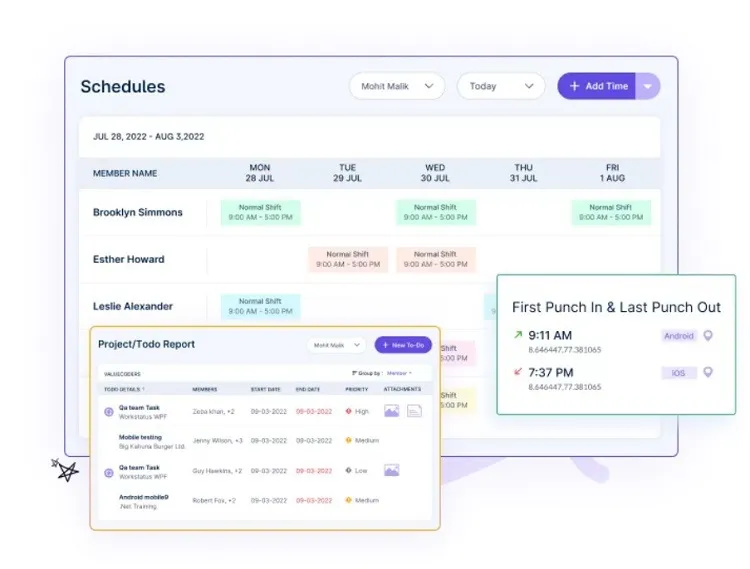
By creating an accurate and fair schedule, employers can ensure that their employees are productive and have sufficient staff to meet customer demand.
2. Employee Performance Management
Employee performance management is a critical element of effective workforce management.
By setting clear expectations and providing ongoing feedback, organizations can help employees thrive in their roles, contributing to the company’s success.
Key Benefits:
- Identification of top-performing employees
- Objective and data-driven evaluation
- Constructive feedback and coaching
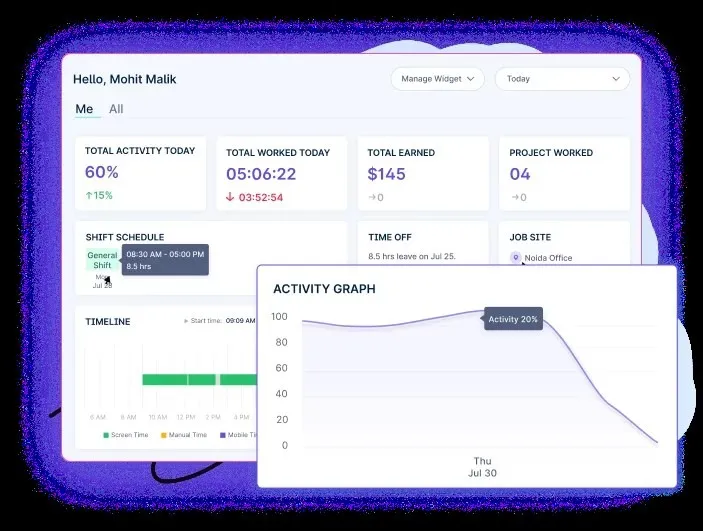
Additionally, it provides a way to fairly measure and compare employees across the company, which can help decide about promotions, pay raises, and other opportunities.
3. Leave Management
Workstatus helps you to manage leaves and absences of the workforce. It typically includes tracking employee leave, managing leave requests, and monitoring leave balances.
Key Benefits:
- Streamlined and automated leave management
- Accurate tracking and reporting
- Flexible and accommodating leave policies
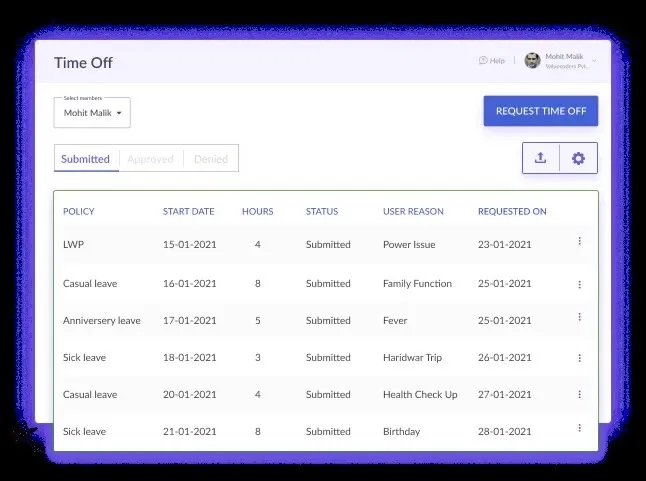
Online systems like Workstatus are often preferred because they allow employees to submit requests electronically, receive updates on the status of their requests, and view their leave balances online.
4. Attendance Management
Workstatus helps in tracking and managing employee attendance. This can include tracking absences, tardiness, and vacation days. It can also involve setting policies around acceptable levels of absenteeism and enforcing those policies.
Key Benefits:
- Compliance with labor laws and regulations
- Improved workforce planning
- Reduced absenteeism and tardiness
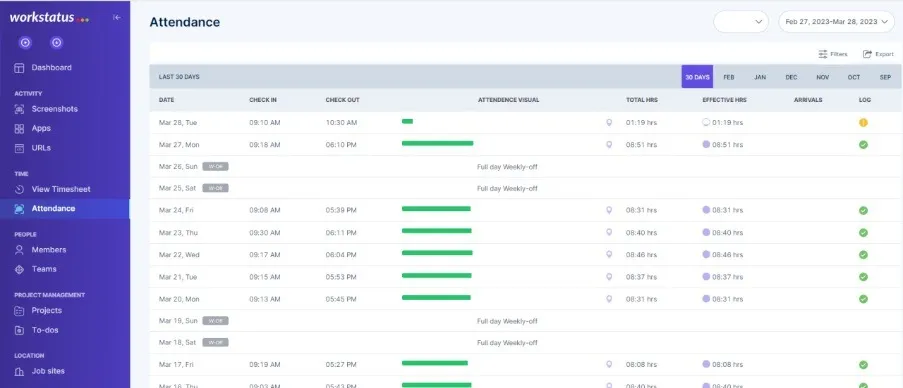
The purpose of attendance management is to ensure that employees are present when needed and to track employee absences to minimize the impact on company productivity.
5. Productivity Tracking
Workstatus offers a robust productivity tracking feature that allows businesses to monitor the productivity of their employees.
Key Benefits:
- Improved productivity and accountability
- Better insight into employee strengths and weaknesses
- Optimized workflow
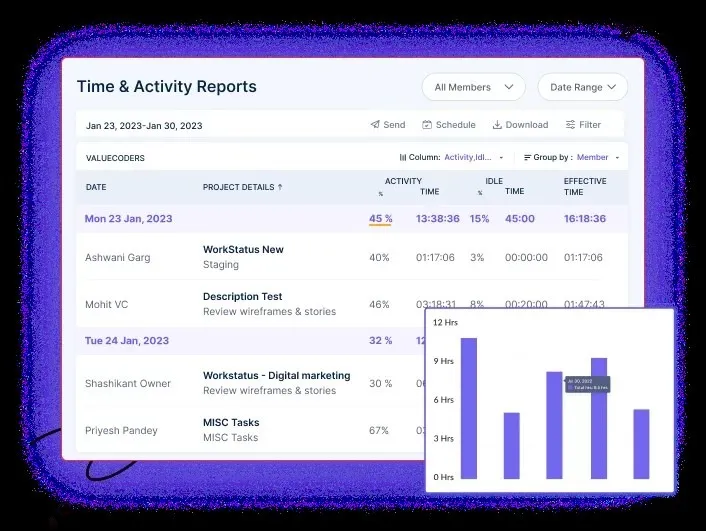
This feature tracks the time spent on tasks, the number of completed tasks, and other metrics that can help businesses identify areas of improvement and optimize their workflow.
6. Employee Monitoring
Workstatus provides employee monitoring capabilities, allowing businesses to keep track of their employees’ activities during work hours.
This feature includes real-time monitoring of employees’ computer screens, keystrokes, and mouse movements, as well as website and application usage.
Key Benefits:
- Enhanced security and compliance
- Proof of work
- Prevent data thefts
![]()
It helps businesses ensure that employees are working productively and helps prevent unauthorized activities that could harm the business.
At last, Workstatus is an excellent tool for enterprises of all sizes looking to increase transparency and accountability in the workplace while increasing workforce productivity.
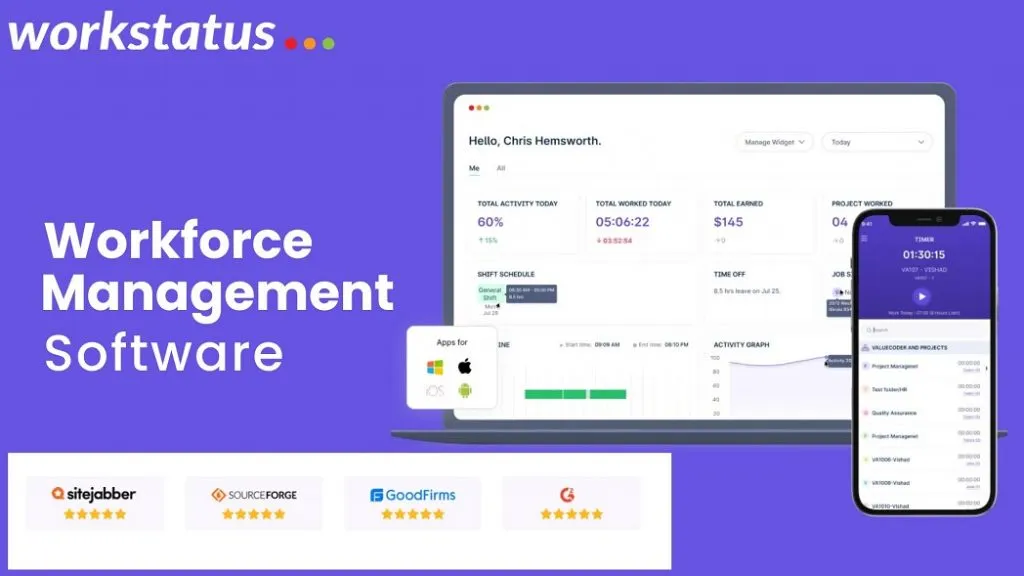
Try it free for 7 days here-
FAQs
Ques. What is workforce management?
Ans. Workforce management is the process of optimizing the productivity and efficiency of an organization’s workforce by aligning staffing needs with business goals. It involves managing employee scheduling, time and attendance tracking, task management, and performance monitoring.
Ques. What are the benefits of workforce management?
Ans. Effective workforce management can lead to improved productivity, better employee engagement, increased job satisfaction, and reduced labor costs. It also helps businesses ensure compliance with labor laws and regulations and provides insights into staffing needs and resource allocation.
Ques. Which is the best workforce management app?
Ans. Workstatus is a highly rated workforce management app that offers a wide range of features such as time tracking, productivity monitoring, project management, and team collaboration tools. It provides businesses with real-time insights into their employees’ performance and helps optimize workforce productivity and efficiency.
Additionally, it offers integrations with various third-party tools such as Trello, Asana, and Jira, making it a flexible option for businesses of all sizes.












